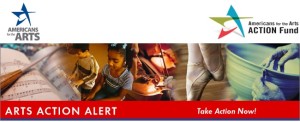Passage of “Every Student Succeeds Act” a big plus for arts education
“Waving” Goodbye to No Child Left Behind provides details of the arts education provisions in the new Every Student Succeeds Act (ESSA) signed into law December 10, 2015.
(via Americans for the Arts’ Arts Action News)
Statement from Robert L. Lynch,
President & CEO of Americans for the Arts,
on the Every Student Succeeds Act
Thursday, December 10, 2015
Today, at the White House, I had the privilege of attending the signing of the Every Student Succeeds Act by President Obama. I joined other education leaders in applauding the end of the No Child Left Behind (NCLB) era and welcoming a new path for the American educational policy landscape. This new law holds great promise for restoring arts education as central to the school day and in the lives of students and our nation’s future workforce.
For 14 years, from 2002 to 2016, NCLB policies resulted in many unintended consequences to schools, teachers, and students across the country. It demanded accountability steps that resulted in a hyper-focus on testing in a few subjects, leaving other core academic subjects—like the arts—to be reduced, or in some places, abandoned. The bill signed today removes this onerous element of NCLB and provides support for a well-rounded education, with all the arts disciplines represented, to be realized throughout the country.
Today is a result of countless advocacy efforts. Americans for the Arts and more than 100 arts and arts education organizations have spent a decade prioritizing arts education legislative objectives. Among these organizations weighing in are discipline-specific groups representing dance, media arts, music, theater, and visual arts, as well as groups representing community-based and out-of-school time programs. The work of this coalition has advanced our objectives as seen by the inclusion of some of our key arts education priorities, including:
- Dedicated funding for arts education through the “Assistance for Arts Education” grant program
- Inclusion of the arts in the “Well-Rounded Education” definition with over a dozen references in the bill ensuring, among other things, that the arts continue to be eligible for Title I funds—the largest federal funding source to local educational agencies and schools.
- Integration of the arts in STEM programs – recognized in the field as “STEM to STEAM”
So what does this all mean for arts education moving forward? For a few years we have anticipated more local control and state level accountability in education. For the arts, this law means that states must invest in new arts education learning standards and resourcing of arts education to encourage creativity in our nation’s classrooms. For education providers, we must seek to provide all students with an education that is shared and coordinated between classroom teachers, arts specialists, and community partners. Because of the national networks fostered at Americans for the Arts—including local arts agencies, arts service organizations, and more—communities are well positioned to take on this shared delivery approach.
In recognition of the leadership shift from the federal level to the states, Americans for the Arts launched in 2014 our State Policy Pilot Program to advance state level arts education policy and ensure equitable access to arts education for all students across a state. We’re working nationally to increase the number of states that are using the arts as a tool to achieve various goals of education reform, such as increasing student performance, improving school climate. Additionally, we’re supporting teams of education leaders from 10 states who are working in a collective impact model to address policy issues like high school graduation requirements and teacher evaluation.
While much work lies ahead in implementing the new federal education policy, today is a day to mark and to celebrate, as we begin the next chapter of education in America. I know that the arts can be a critical component in ensuring that every student will succeed in school, work, and life. I call on all of the artists, educators, philanthropy partners, state and local arts agencies and arts advocates involved with Americans for the Arts to stand ready to move education forward together.
